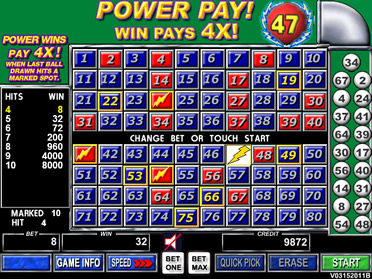In an age of multimillion dollar interstate lotteries that draw massive public interest, the game of keno offers the casino equivalent of a new lottery every few minutes.
Keno is a game of chance based on correctly guessing numbers, and it plays out very closely to the Powerball or other lottery games. Players select anywhere from one to 15 numbers (usually the selection ranges from six to eight though), and 20 random numbers are then drawn from a selection of 80 possibilities. The amount of numbers you select that match the drawn numbers determines your payout, using an escalating scale according to the odds against.
An inexpensive alternative to the often pricey table games offered in most casinos, keno is a great option for players looking for a little action on the cheap. A single keno ticket usually costs just $1, and with payouts rising up to $25,000 to 1 for matching eight out of eight numbers, the game offers the always tempting prospect of an enormous jackpot for just a tiny investment.
Of course, with any simple to grasp game of chance spread in a casino, the odds greatly favor the house in keno. It will never be a skill based game played for profit, but as a pure gamble with a little on the line and a lot up for grabs, you can’t beat keno.
Top Casinos
Keno Basics

To play keno you’ll begin by grabbing a playing ticket from one of the employees staffing the keno areas. These keno runners will take your written ticket to the cage and exchange it for an official betting slip.
The keno playing ticket is an 8×10 grid comprised of eight rows and 10 columns. The numbers 1-80 are arranged in the grid in sequential order.
Simply check off, circle, or otherwise mark the numbers (or spots) you’d like to play. You can choose one number, 15 numbers, or anywhere in between. According to proper keno strategy, however, the optimal amount of numbers to choose is between six and eight.
To clarify exactly how many numbers you’re playing, some tickets will include a space for numbers played. You’ll also notice a box marked price, and this is where you enter the dollar amount you’d like to wager on each game.
Finally, you can write in the amount of games (usually called races) you’d like to play with the particular selection of numbers on that ticket. A multi-race ticket set for seven races and $1 would therefore cost the player $7, and the same selection of numbers would be used for the next seven draws.
After submitting your completed ticket to the runner, and receiving an official betting slip in return, take a moment to closely check this slip. Mistakes are rare in the closely controlled casino environment, but in the event your chosen numbers don’t match the official betting slip, the latter always takes precedence when disputes arise. So always make sure the numbers you want are on the betting slip, and if they aren’t, don’t hesitate to ask the runner for a replacement. They’ll be more than happy to assist you.
With your betting slip in hand simply sit back and watch the show. The numbers will be drawn automatically by the casino, usually on a tight schedule of one draw every 5-10 minutes. You can get comfortable in the keno lounge to watch the numbers for each race pop up, or head out onto the casino floor to enjoy other games while keeping one eye on the overhead keno monitors displaying results from the most recent draw.
However you sweat the keno action, the thrill of reading the results and matching them to your ticket one number at a time is a unique experience. The payouts for matching multiple numbers in keno are typically quite generous, and while the feat is a statistical improbability, turning in a winning ticket with five, six, seven, or eight matches can result in a bankroll building score for just a few bucks.
The Strategy of Keno
As a pure game of chance, keno is not really the best game through which to apply skills or strategy. With a house edge of right around 30 percent, keno is actually one of the worst bets on the floor for players. However, as an inexpensive one time shot while enjoying the keno experience, players could do worse.
While you can’t reduce that average house edge of 30 percent, you can maximize your chances of running into a maximum payout in the event your luck runs hot. In order to do this, first take a look at the following chart illustrating the odds against matching multiple numbers, along with the standard payouts on a $1 wager:
| Numbers Selected and Hit | Odds of Hitting (1 in X) | Average Payout on $1 Wager |
|---|---|---|
| 10 out of 10 | 8,911,711 | $25,000 |
| 9 out of 10 | 163,381 | $4,000 |
| 8 out of 10 | 7,384 | $1,000 |
| 7 out of 10 | 621 | $140 |
| 6 out of 10 | 87 | $20 |
| 8 out of 8 | 230,114 | $25,000 |
| 7 out of 8 | 6,232 | $1,480 |
| 6 out of 8 | 423 | $90 |
| 7 out of 7 | 40,979 | $8,100 |
| 6 out of 7 | 1,366 | $400 |
| 6 out of 6 | 7,752 | $1,480 |
| 5 out of 6 | 323 | $90 |
The key bit of information to emerge from this data shows that keno players can score the maximum payout of 25,000 to 1 in one of two ways: matching 10 out of 10 numbers, or matching eight out of eight.
But while the payouts for both wins are the same, at $25,000 for a $1 bet, the odds against matching 10 numbers with 10 selections stand at a staggering 8.9 million to one.
When you compare this to the odds against matching eight numbers with eight selections, which stand at just 230,114 to one, you see which one is a better bet. Furthermore, you can haul in the second-largest keno payout (8,100 to 1) by matching seven out of seven.
While new players try to go for the gusto by picking 10 numbers or more, experienced keno players know that the sweet spot for number selections sits between six and eight.
Another strategy to employ when playing keno is to avoid strategies. Always remember that this is a game of chance, so any time somebody suggests to you that they’ve cracked the code or otherwise figured out a way to predict the numbers drawn, discount their claims as nothing more than superstition. The best way to lose a lot of money playing keno is by believing that you can somehow beat a game based on randomization and chance.
Keno Betting Variations
While simply picking single numbers is one way to play keno, this can quickly become a boring game altogether. To spice things up, keno players often use different groupings to select their spots on a ticket.
You can circle groups of numbers on your keno ticket to make a way bet. This wager can be made in multiple forms, but the idea behind the way bet is that you’re playing several sets of numbers on the same card.
With a 3x3x3 way bet, for example, you’d circle three different sets of three numbers each. This gives you one ticket that essentially represents three tickets, as any of the three sets you’ve circled are now in play. As such, this bet would cost $3 if you’re betting at the $1 minimum, but with way betting, each circled group is considered to be a separate wager and costs one more unit.
Another way to wager on keno is the combination bet. This simply allows you to combine the numbers from each circled group in a way bet to form several new number sets that are now in play.
For example, on a 3x3x3 way bet you could circle the following groups: [3,6,10], [12,19,22], and [50,60,70]. With a way bet, your ticket is a winner when any complete three-number set arrives on the draw. So if the 3, 6, 10, 12, 19, and 22 all appeared among the drawn numbers, you’d win two separate 3-out-of-3 wagers.
With a combination bet using the same numbers, you could have the 3, 6, 12, 19, 50, and 60 all arrive among the drawn numbers and still win. Even though these would not complete any of the three-number sets, by mixing numbers from each set you’d have several different winning combinations.






